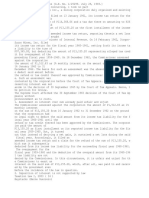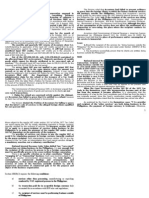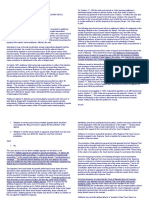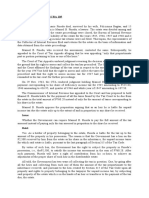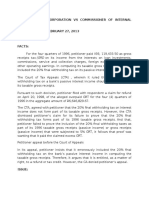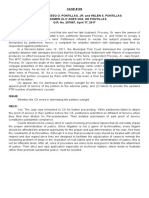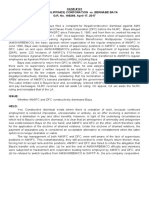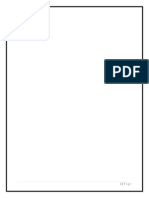13.d CIR vs. CA and BPI (G.R. No. 117254 January 21, 1999) - H Digest
13.d CIR vs. CA and BPI (G.R. No. 117254 January 21, 1999) - H Digest
Uploaded by
HarleneCopyright:
Available Formats
13.d CIR vs. CA and BPI (G.R. No. 117254 January 21, 1999) - H Digest
13.d CIR vs. CA and BPI (G.R. No. 117254 January 21, 1999) - H Digest
Uploaded by
HarleneOriginal Title
Copyright
Available Formats
Share this document
Did you find this document useful?
Is this content inappropriate?
Copyright:
Available Formats
13.d CIR vs. CA and BPI (G.R. No. 117254 January 21, 1999) - H Digest
13.d CIR vs. CA and BPI (G.R. No. 117254 January 21, 1999) - H Digest
Uploaded by
HarleneCopyright:
Available Formats
G.R. No.
117254 January 21, 1999
COMMISSIONER OF INTERNAL REVENUE, petitioner, vs.
COURT OF APPEALS, COURT OF TAX APPEALS and BANK OF THE PHILIPPINE ISLANDS as LIQUIDATOR OF
PARAMOUNT ACCEPTANCE CORPORATION, respondent.
TOPIC: Remedies available to taxpayer -> After payment -> Refund -> Period within which to file a claim for
refund -> General Rule is two (2) years from the date of payment
FACTS:
Petitioner BPI, a bank and trust corporation, acts as the liquidator of Paramount Acceptance Corporation after the
latter’s dissolution on March 31, 1986.
On April 2, 1986, Paramount filed its Corporate Annual Income Tax Return, for calendar year ending December 31,
1985, declaring a Net Income of P3,324,802.00. The income tax due thereon is P1,153,681.00. However,
Paramount paid the BIR its quarterly income tax with total amount of P1,218,940.00 for the last three (3) quarters.
The appropriate box in the return was marked with a cross (x) indicating "To be refunded" he amount of P65,29,00.
In April 14, 1988, petitioner BPI, as liquidator of Paramount, through counsel filed a letter dated April 12, 1988
reiterating its claim for refund of P65,259.00 as overpaid income tax for the calendar year 1985. The following day
or on April 15, 1988. BPI filed the instant petition with the CTA in order to toll the running of the prescriptive period
for filing a claim for refund of overpaid income taxes.
The Court of Tax Appeals rendered a decision considering the two year period of prescription to have commenced
to run from April 15, 1986, the last day for filing the corporate income tax return, and, since the claim for refund was
filed on April 14, 1988 and the action was brought on April 15, 1988, it held that prescription had not set in. CIR was
ordered to refund the Paramount/BPI.
CA affirmed CTA.
ISSUE:
Whether the two-year period of prescription for filing a claim for refund is to be counted from April 2, 1986 when the
corporate income tax return was actually filed or from April l5, 1986 when, according to Section 70(b) of the NIRC,
the final adjustment return could still be filed without incurring any penalty.
HELD: April 2, 1986, when the final adjustment return was actually filed.
Section 230 of the NLRC provides that two-year period of prescription must be counted "from the date of payment
of the tax.
Prescriptive period should be computed from April 2, 1984, when the final adjustment return was actually filed,
because that is the time of payment of the tax, within the meaning of Section 230 of the NIRC.
The ruling in various decided cases that the two-year period should be computed from the time of actual filing of
the Adjustment Return or Annual Income Tax Return, is so because at that point, it can already be determined
whether there has been an overpayment by the taxpayer. Moreover, under Section 49(a) of the NIRC, payment is
made at the time the return is filed.
In the case at bar, Paramount filed its corporate annual income tax return on April 2, 1986. However, private
respondent BPI, as liquidator of Paramount, filed a written claim for refund only on April 14, 1988 and a petition for
refund only on April 15, 1988. Both claim and action for refund were thus barred by prescription.
WHEREFORE, the decision of the Court of Appeals is REVERSED and the petition for refund filed by private
respondent is DISMISSED on the ground that it is barred by prescription.
-harl- 1
You might also like
- PBC vs. CIRDocument1 pagePBC vs. CIRMarife MinorNo ratings yet
- BIR Vs CA and Sps. ManlyDocument1 pageBIR Vs CA and Sps. ManlyJayNo ratings yet
- W-1QMBR Medicare Savings Redetermination Form PDFDocument3 pagesW-1QMBR Medicare Savings Redetermination Form PDFehaegertNo ratings yet
- CIR vs. Filinvest Dev't Corp.Document2 pagesCIR vs. Filinvest Dev't Corp.Direct LukeNo ratings yet
- Cir V Itogon-Suyoc MinESDocument2 pagesCir V Itogon-Suyoc MinESkeloNo ratings yet
- Case 59 CS Garments Vs CirDocument3 pagesCase 59 CS Garments Vs CirJulian Guevarra0% (1)
- Taganito vs. Commissioner (1995)Document2 pagesTaganito vs. Commissioner (1995)cmv mendozaNo ratings yet
- CIRvsCA 104151 1995 DigestDocument1 pageCIRvsCA 104151 1995 DigestJeremiahN.CaballeroNo ratings yet
- Solidbank v. Mindanao Ferroalloy CorpDocument3 pagesSolidbank v. Mindanao Ferroalloy CorpIra Francia AlcazarNo ratings yet
- Far East Bank and Trust Company As Trustee of Various Retirement FundsDocument1 pageFar East Bank and Trust Company As Trustee of Various Retirement FundsellaNo ratings yet
- CIR V AcesiteDocument2 pagesCIR V AcesiteAleli Joyce BucuNo ratings yet
- BIR Ruling (DA-287-07) May 8, 2007Document3 pagesBIR Ruling (DA-287-07) May 8, 2007Raiya AngelaNo ratings yet
- Cir vs. Meralco G.R. No. 181459, June 9, 2014Document1 pageCir vs. Meralco G.R. No. 181459, June 9, 2014Rusty NomadNo ratings yet
- Sarasola V TrinidadDocument1 pageSarasola V Trinidadgel94No ratings yet
- Commissioner of Internal Revenue vs. Pilipinas Shell Petroleum CorporationDocument3 pagesCommissioner of Internal Revenue vs. Pilipinas Shell Petroleum CorporationmjpjoreNo ratings yet
- CIR V Toledo (2015)Document2 pagesCIR V Toledo (2015)Anonymous bOncqbp8yiNo ratings yet
- Tax Rev Case DigestDocument7 pagesTax Rev Case DigestKent Wilson Orbase AndalesNo ratings yet
- Accenture Vs CirDocument2 pagesAccenture Vs CirCess EspinoNo ratings yet
- People v. CastanedaDocument3 pagesPeople v. CastanedaAiken Alagban LadinesNo ratings yet
- Javier v. AnchetaDocument1 pageJavier v. AnchetaGSS100% (1)
- 05 - Dison vs. PosadasDocument2 pages05 - Dison vs. Posadascool_peach100% (1)
- 15 - Western Mindanao Power Corporation v. CIRDocument3 pages15 - Western Mindanao Power Corporation v. CIRPaula Marquez MenditaNo ratings yet
- 09 - People v. Hu GR No. 182232 - Full TextDocument6 pages09 - People v. Hu GR No. 182232 - Full TextKornessa ParasNo ratings yet
- Republic of The PH vs. Lim de Yu DGDocument1 pageRepublic of The PH vs. Lim de Yu DGKimberly RamosNo ratings yet
- March 15, 2017 G.R. No. 192536 - Alcantara Vs RepublicDocument1 pageMarch 15, 2017 G.R. No. 192536 - Alcantara Vs RepublicRichel Dean SolisNo ratings yet
- Tambunting v. CIRDocument4 pagesTambunting v. CIRlouis jansenNo ratings yet
- Limpan Vs CIRDocument5 pagesLimpan Vs CIRBenedick LedesmaNo ratings yet
- CIR v. Mirant PagbilaoDocument4 pagesCIR v. Mirant Pagbilaoamareia yap100% (1)
- Alejandro v. GeraldezDocument12 pagesAlejandro v. GeraldezBenedick LedesmaNo ratings yet
- Eastern Telecommunications Phil Inc V CIR - DigestDocument1 pageEastern Telecommunications Phil Inc V CIR - DigestKate GaroNo ratings yet
- Republic V Aquafresh SeafoodDocument2 pagesRepublic V Aquafresh SeafoodRia Evita RevitaNo ratings yet
- ME Holding Corporation vs. CA GR No. 160193Document8 pagesME Holding Corporation vs. CA GR No. 160193Charish DanaoNo ratings yet
- City of Baguio v. Fortunato de Leon GR L-24756Document1 pageCity of Baguio v. Fortunato de Leon GR L-24756Charles Roger RayaNo ratings yet
- Metropolitan Waterworks Sewerage System, Petitioner, vs. The Local Government of Quezon CityDocument3 pagesMetropolitan Waterworks Sewerage System, Petitioner, vs. The Local Government of Quezon Citysahara lockwoodNo ratings yet
- Lopez vs. City of ManilaDocument2 pagesLopez vs. City of ManilaDeniel Salvador B. MorilloNo ratings yet
- Far East Bank & Trust Company (FEBTC) v. Commissioner of Internal Revenue G.R. NO. 149589, September 15, 2006Document1 pageFar East Bank & Trust Company (FEBTC) v. Commissioner of Internal Revenue G.R. NO. 149589, September 15, 2006Ria Evita RevitaNo ratings yet
- Philippine American Life V Sec of Finance Gr210987Document2 pagesPhilippine American Life V Sec of Finance Gr210987Adi Lim100% (1)
- Wonder Mechanical Engineering Corporation vs. Cta & BirDocument2 pagesWonder Mechanical Engineering Corporation vs. Cta & BirMarky RamoneNo ratings yet
- Cases For DigestDocument14 pagesCases For Digestjobelle barcellanoNo ratings yet
- CIR V StanleyDocument15 pagesCIR V StanleyPatatas SayoteNo ratings yet
- Eduardo R. Alicias, Jr. vs. Atty. Myrna v. MacatangayDocument2 pagesEduardo R. Alicias, Jr. vs. Atty. Myrna v. MacatangayMona LizaNo ratings yet
- Collector v. LaraDocument2 pagesCollector v. LaraJaypoll DiazNo ratings yet
- RCAM v. CADocument3 pagesRCAM v. CACocoyPangilinanNo ratings yet
- Philamlife V Cta Case DigestDocument2 pagesPhilamlife V Cta Case DigestAnonymous BvmMuBSwNo ratings yet
- Philippine Match Co vs. City of CebuDocument4 pagesPhilippine Match Co vs. City of CebuKC ToraynoNo ratings yet
- CIR vs. Burroghs, G.R. No. 66653, June 19, 1986Document1 pageCIR vs. Burroghs, G.R. No. 66653, June 19, 1986Oro ChamberNo ratings yet
- (Digest) CIR v. Pineda, 21 SCRA 105Document2 pages(Digest) CIR v. Pineda, 21 SCRA 105Homer SimpsonNo ratings yet
- China Banking Corporation Vs Commissioner of Internal RevenueDocument6 pagesChina Banking Corporation Vs Commissioner of Internal Revenuemarc bantugNo ratings yet
- CIR Vs General FoodsDocument4 pagesCIR Vs General FoodsMonaVargasNo ratings yet
- Taxation Digest - PAGCOR vs. BIRDocument3 pagesTaxation Digest - PAGCOR vs. BIRMaestro LazaroNo ratings yet
- Garrison v. CADocument2 pagesGarrison v. CAershakiNo ratings yet
- Sony v. CIRDocument2 pagesSony v. CIRMaya Julieta Catacutan-EstabilloNo ratings yet
- Batch 2 - Digested Cases in TaxationDocument20 pagesBatch 2 - Digested Cases in Taxationnikkolad100% (2)
- Case Digest of GR No 153204Document1 pageCase Digest of GR No 153204Ivan ChuaNo ratings yet
- Surigao v. CTADocument2 pagesSurigao v. CTAjdpajarilloNo ratings yet
- Republic vs. Hizon (December 13, 1999) - VALIX G.R. No. 130430. December 13, 1999 DoctrineDocument2 pagesRepublic vs. Hizon (December 13, 1999) - VALIX G.R. No. 130430. December 13, 1999 DoctrineCinNo ratings yet
- I.3 Gaston Vs Republic Planter GR No. 77194 03151988 PDFDocument3 pagesI.3 Gaston Vs Republic Planter GR No. 77194 03151988 PDFbabyclaire17No ratings yet
- COMMISSIONER OF INTERNAL REVENUE, Petitioner, vs. CITYTRUST INVESTMENT PHILS., INC., Respondent.Document1 pageCOMMISSIONER OF INTERNAL REVENUE, Petitioner, vs. CITYTRUST INVESTMENT PHILS., INC., Respondent.Charles Roger Raya100% (1)
- Case Digest San Fernando Rural Bank Vs Pampanga Omnibus DevelopmentDocument4 pagesCase Digest San Fernando Rural Bank Vs Pampanga Omnibus DevelopmentConsuelo Narag GalagalaNo ratings yet
- CORAL BAY NICKEL CORPORATION v. COMMISSIONER OF INTERNAL REVENUEDocument2 pagesCORAL BAY NICKEL CORPORATION v. COMMISSIONER OF INTERNAL REVENUELee OhNo ratings yet
- BPI vs. CIRDocument5 pagesBPI vs. CIRmatinikki100% (1)
- CASE #104 Bureau of Internal Revenue, Et. Al. vs. Lepanto Ceramics, Inc. G.R. No. 224764, April 24, 2017 FactsDocument2 pagesCASE #104 Bureau of Internal Revenue, Et. Al. vs. Lepanto Ceramics, Inc. G.R. No. 224764, April 24, 2017 FactsHarleneNo ratings yet
- CASE #106 Sps. Elvira and Edwin Alcantara vs. Sps. Zenaida and Florante Belen, Et. Al G.R. No. 200204 Dated April 25,2017 FactsDocument2 pagesCASE #106 Sps. Elvira and Edwin Alcantara vs. Sps. Zenaida and Florante Belen, Et. Al G.R. No. 200204 Dated April 25,2017 FactsHarleneNo ratings yet
- CASE # 105 BERNADETTE S. BILAG, Et. Al. Vs ESTELA AY-AY, Et. Al. G.R. No. 189950, April 24, 2017 FactsDocument2 pagesCASE # 105 BERNADETTE S. BILAG, Et. Al. Vs ESTELA AY-AY, Et. Al. G.R. No. 189950, April 24, 2017 FactsHarleneNo ratings yet
- CASE #103 Joselito Bustos vs. Millians Shoe, Inc., Sps. Fernando and Amelia Cruz G.R. No. 185024, April 4, 2017 FactsDocument2 pagesCASE #103 Joselito Bustos vs. Millians Shoe, Inc., Sps. Fernando and Amelia Cruz G.R. No. 185024, April 4, 2017 FactsHarleneNo ratings yet
- CASE #107 Pablo and Pablina Marcelo-Mendoza vs. Peroxide Phils., Inc., Herein Represented by ROBERT R. NAVERA, G.R. No. 203492, April 24, 2017 FactsDocument2 pagesCASE #107 Pablo and Pablina Marcelo-Mendoza vs. Peroxide Phils., Inc., Herein Represented by ROBERT R. NAVERA, G.R. No. 203492, April 24, 2017 FactsHarleneNo ratings yet
- CASE #121 Nenita de Guzman Ferguson vs. Atty. Salvador P. Ramos A.C. No. 9209, April 18, 2017 FactsDocument2 pagesCASE #121 Nenita de Guzman Ferguson vs. Atty. Salvador P. Ramos A.C. No. 9209, April 18, 2017 FactsHarleneNo ratings yet
- CASE #113 Baclaran Marketing Corp. vs. Fernando C. Nieva and Mamerto Sibulo, Jr. G.R. No. 189881, April 19, 2017 FactsDocument2 pagesCASE #113 Baclaran Marketing Corp. vs. Fernando C. Nieva and Mamerto Sibulo, Jr. G.R. No. 189881, April 19, 2017 FactsHarlene100% (1)
- CASE #112 Asiatrust Development Bank, Inc. vs. Commissioner of Internal Revenue G.R. No. 201530, April 19, 2017 FactsDocument2 pagesCASE #112 Asiatrust Development Bank, Inc. vs. Commissioner of Internal Revenue G.R. No. 201530, April 19, 2017 FactsHarleneNo ratings yet
- CASE #114 TGN Realty Corporation vs. Villa Teresa Homeowners Association, Inc. G.R. No. 164795, April 19, 2017 FactsDocument2 pagesCASE #114 TGN Realty Corporation vs. Villa Teresa Homeowners Association, Inc. G.R. No. 164795, April 19, 2017 FactsHarlene100% (1)
- CASE #108 University of Santo Tomas (Ust) vs. Samahang Manggagawa NG Ust, Et. Al. G.R. No. 184262, April 24, 2017 FactsDocument2 pagesCASE #108 University of Santo Tomas (Ust) vs. Samahang Manggagawa NG Ust, Et. Al. G.R. No. 184262, April 24, 2017 FactsHarleneNo ratings yet
- C.F. Sharp Crew Management, Inc., Et. Al. vs. Rhudel A. Castillo G.R. No. 208215, April 19, 2017Document2 pagesC.F. Sharp Crew Management, Inc., Et. Al. vs. Rhudel A. Castillo G.R. No. 208215, April 19, 2017HarleneNo ratings yet
- CASE #110 Philippine Steel Coating Corp. vs. Eduard Quinones G.R. No. 194533, April 19, 2017 FactsDocument2 pagesCASE #110 Philippine Steel Coating Corp. vs. Eduard Quinones G.R. No. 194533, April 19, 2017 FactsHarleneNo ratings yet
- Joseph C. Dimapilis vs. Commission On Elections G.R. No. 227158, April 18, 2017Document2 pagesJoseph C. Dimapilis vs. Commission On Elections G.R. No. 227158, April 18, 2017HarleneNo ratings yet
- CASE #111 Bankard, Inc. vs. Luz P. Alarte G.R. No. 202573, April 19, 2017 FactsDocument1 pageCASE #111 Bankard, Inc. vs. Luz P. Alarte G.R. No. 202573, April 19, 2017 FactsHarleneNo ratings yet
- CASE #124 Eduardo Quimvel vs. People of The Philippines G.R. No. 214497, April 18, 2017 FactsDocument2 pagesCASE #124 Eduardo Quimvel vs. People of The Philippines G.R. No. 214497, April 18, 2017 FactsHarlene100% (1)
- CASE #122 Gloria Macapagal Arroyo vs. People of The Philippines and Sandiganbayan G.R. No. 220598, April 18, 2017 FactsDocument2 pagesCASE #122 Gloria Macapagal Arroyo vs. People of The Philippines and Sandiganbayan G.R. No. 220598, April 18, 2017 FactsHarleneNo ratings yet
- NINI A. LANTO, Then Director II of Admin Branch of POEA Vs COMMISSION ON AUDIT (COA) G.R. No. 217189, April 18, 2017Document2 pagesNINI A. LANTO, Then Director II of Admin Branch of POEA Vs COMMISSION ON AUDIT (COA) G.R. No. 217189, April 18, 2017HarleneNo ratings yet
- New Guidelines On The Filing of Applications For Optional Retirement) For Continuing To Function As ADocument1 pageNew Guidelines On The Filing of Applications For Optional Retirement) For Continuing To Function As AHarleneNo ratings yet
- CASE #130 Ultra Mar Aqua Resource, Inc. vs. Fermida Construction Services G.R. No. 191353, April 17, 2017 FactsDocument2 pagesCASE #130 Ultra Mar Aqua Resource, Inc. vs. Fermida Construction Services G.R. No. 191353, April 17, 2017 FactsHarleneNo ratings yet
- CASE #127 Ramon R. Villarama vs. Atty. Clodualdo C. de Jesus G.R. No. 217004, April 17, 2017 FactsDocument2 pagesCASE #127 Ramon R. Villarama vs. Atty. Clodualdo C. de Jesus G.R. No. 217004, April 17, 2017 FactsHarleneNo ratings yet
- Development Bank of The Philippines vs. Commission On Audit G.R. No. 216538, April 18, 2017Document2 pagesDevelopment Bank of The Philippines vs. Commission On Audit G.R. No. 216538, April 18, 2017HarleneNo ratings yet
- CASE #126 Lo Loy Unduran, Et. Al. vs. Ramon Aberasturi, Et. Al. G.R. No. 181284, April 18, 2017 FactsDocument1 pageCASE #126 Lo Loy Unduran, Et. Al. vs. Ramon Aberasturi, Et. Al. G.R. No. 181284, April 18, 2017 FactsHarleneNo ratings yet
- Respondents: Land Bank of The Philippines vs. West Bay Colleges, Inc., Et. Al. G.R. No. 211287, April 17, 2017Document1 pageRespondents: Land Bank of The Philippines vs. West Bay Colleges, Inc., Et. Al. G.R. No. 211287, April 17, 2017HarleneNo ratings yet
- CASE #129 Spouses Proceso O. Pontillas, Jr. and Helen S. Pontillas vs. Carmen Oliy Ares Vda. de Pontillas G.R. No. 207667, April 17, 2017 FactsDocument1 pageCASE #129 Spouses Proceso O. Pontillas, Jr. and Helen S. Pontillas vs. Carmen Oliy Ares Vda. de Pontillas G.R. No. 207667, April 17, 2017 FactsHarleneNo ratings yet
- CASE #135 Herma Shipyard, Inc, and Mr. Herminio Esguerra vs. Danilo Oliveros, Et. Al. G.R. No. 208936, April 17, 2017 FactsDocument1 pageCASE #135 Herma Shipyard, Inc, and Mr. Herminio Esguerra vs. Danilo Oliveros, Et. Al. G.R. No. 208936, April 17, 2017 FactsHarleneNo ratings yet
- CASE #134 Roberto P. Fuentes vs. People of The Philippines G.R. No. 186421, April 17, 2017 FactsDocument2 pagesCASE #134 Roberto P. Fuentes vs. People of The Philippines G.R. No. 186421, April 17, 2017 FactsHarlene100% (1)
- CASE #133 Re: Dropping From The Rolls of Rowie A. Quimno, Utility Worker I, MCTC, Lpil, Zamboanga Sibugay, A.M. No. 17-03-33-MCTC, April 17, 2017 FactsDocument1 pageCASE #133 Re: Dropping From The Rolls of Rowie A. Quimno, Utility Worker I, MCTC, Lpil, Zamboanga Sibugay, A.M. No. 17-03-33-MCTC, April 17, 2017 FactsHarleneNo ratings yet
- CASE #132 City of Davao vs. Robert E. Olanolan G.R. No. 181149, April 17, 2017 FactsDocument2 pagesCASE #132 City of Davao vs. Robert E. Olanolan G.R. No. 181149, April 17, 2017 FactsHarleneNo ratings yet
- CASE #131 Sumifru (Philippines) Corporation vs. Bernabe Baya G.R. No. 188269, April 17, 2017 FactsDocument2 pagesCASE #131 Sumifru (Philippines) Corporation vs. Bernabe Baya G.R. No. 188269, April 17, 2017 FactsHarleneNo ratings yet
- CASE #137 CONCEPCION C. DAPLAS, City Treasurer, Pasay City vs. DEPARTMENT OF FINANCE, Et. Al G.R. No. 221153, April 17, 2017 FactsDocument2 pagesCASE #137 CONCEPCION C. DAPLAS, City Treasurer, Pasay City vs. DEPARTMENT OF FINANCE, Et. Al G.R. No. 221153, April 17, 2017 FactsHarleneNo ratings yet
- The Scribes Journal of Legal WritingDocument192 pagesThe Scribes Journal of Legal WritingEmanuel100% (1)
- Using Point Headings To Make A PointDocument2 pagesUsing Point Headings To Make A PointGregory BerryNo ratings yet
- Labour Law and Industrial RelationsDocument17 pagesLabour Law and Industrial RelationsMatDahe MatSotoNo ratings yet
- Chapter Four: Compliance AuditingDocument21 pagesChapter Four: Compliance AuditingFackallofyou100% (1)
- Filipinas Broadcasting Network, Inc., V Ago DigestDocument4 pagesFilipinas Broadcasting Network, Inc., V Ago DigestShanne Sandoval-Hidalgo100% (5)
- Delhi Domestic Working WomenDocument3 pagesDelhi Domestic Working WomenKeshav Aggarwal100% (2)
- Corpo-Baltazar Vs Lingayen CorpDocument2 pagesCorpo-Baltazar Vs Lingayen CorpJoesil Dianne SempronNo ratings yet
- Pesigan Vs AngelesDocument1 pagePesigan Vs AngelesKariz EscañoNo ratings yet
- Crimprooutline GDocument38 pagesCrimprooutline GAlbert Wong100% (2)
- 376 ESQUIBIL Velazco v. BlasDocument1 page376 ESQUIBIL Velazco v. BlasCarissa CruzNo ratings yet
- Pp. vs. Temporada G.R. No. 173473Document26 pagesPp. vs. Temporada G.R. No. 173473Dat Doria PalerNo ratings yet
- Cunanan vs. ArceoDocument7 pagesCunanan vs. ArceoEarlene DaleNo ratings yet
- Taxation 2 (Part 2 Cases)Document131 pagesTaxation 2 (Part 2 Cases)Lemuel Angelo M. EleccionNo ratings yet
- Adwokat DR Piotr Sobanski Request For Divorce in Polish LawDocument2 pagesAdwokat DR Piotr Sobanski Request For Divorce in Polish Lawadwokat-Zielona-Gora100% (1)
- TNEGC - PDF - Electrical Grid - Electrical SubstationDocument1 pageTNEGC - PDF - Electrical Grid - Electrical SubstationR BaskarNo ratings yet
- Jison vs. Court of Appeals 164 SCRA 339 No. L 45349 August 15 1988Document7 pagesJison vs. Court of Appeals 164 SCRA 339 No. L 45349 August 15 1988CherNo ratings yet
- Comparative Criminal Justice Systems 5th Edition 2024 Scribd DownloadDocument51 pagesComparative Criminal Justice Systems 5th Edition 2024 Scribd Downloadkhivituyetvp100% (1)
- Chapter 10 MindMap PDFDocument2 pagesChapter 10 MindMap PDFsongs 2019 MalikNo ratings yet
- AntidiskriminacijaDocument26 pagesAntidiskriminacijaKanitaNo ratings yet
- Presumption Under POCSO Act: Resumption To FfencesDocument7 pagesPresumption Under POCSO Act: Resumption To FfencesamanNo ratings yet
- Facebook Trafficking RulingDocument2 pagesFacebook Trafficking RulingElizabeth Nolan BrownNo ratings yet
- Manuel Jesus Olivas-Matta, A021 179 705 (BIA Aug. 9, 2010)Document25 pagesManuel Jesus Olivas-Matta, A021 179 705 (BIA Aug. 9, 2010)Immigrant & Refugee Appellate Center, LLCNo ratings yet
- Affidavit of Intent and Consent To Adoption of ChildDocument2 pagesAffidavit of Intent and Consent To Adoption of ChildGenesy TimoneraNo ratings yet
- UGANDA Vs THOMAS KWOYELO Alias LATONI CONFIRMATION OF CHARGES RULING PDFDocument62 pagesUGANDA Vs THOMAS KWOYELO Alias LATONI CONFIRMATION OF CHARGES RULING PDFsarah kihika0% (1)
- Mark Meadows Contempt ReportDocument51 pagesMark Meadows Contempt ReportDaily KosNo ratings yet
- Mandarin Villa, Inc. V. Court of Appeals: GR. No. 119850, June 20, 1996Document8 pagesMandarin Villa, Inc. V. Court of Appeals: GR. No. 119850, June 20, 1996mvenderNo ratings yet
- Health Law1 DksDocument16 pagesHealth Law1 Dksdsingh1092No ratings yet
- Form C PDFDocument3 pagesForm C PDFNishanth Baratam100% (1)
- 9 Motion To Withdraw As CounselDocument3 pages9 Motion To Withdraw As Counselmia tejeroNo ratings yet




